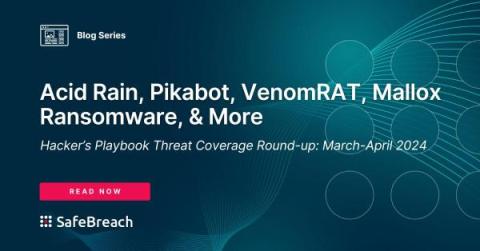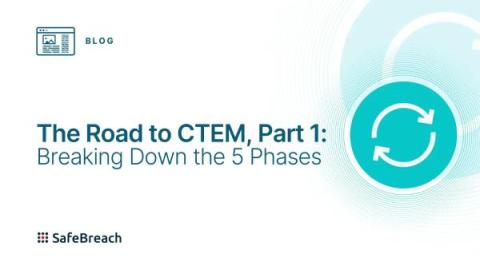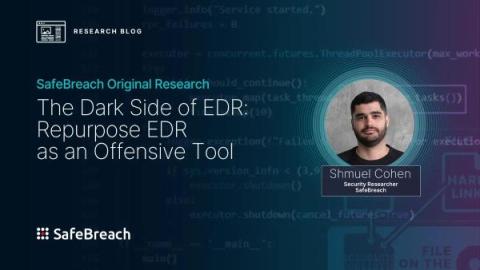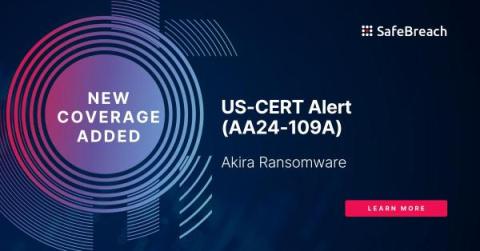Security | Threat Detection | Cyberattacks | DevSecOps | Compliance
SafeBreach
AI Threat Scenario, GuLoader, DarkGate, MirrorBlast, Kutaki Stealer and More - Hacker's Playbook Threat Coverage Round-up: May 2024
In this version of the Hacker’s Playbook Threat Coverage round-up, we are highlighting attack coverage for newly discovered or analyzed threats, including a newly created scenario that leverages AI Generated malware. SafeBreach customers can select and run these attacks and more from the SafeBreach Hacker’s Playbook to ensure coverage against these advanced threats. Additional details about the threats and our coverage can be seen below.
Evolving Detection Engineering Capabilities with Breach & Attack Simulation (BAS)
Threat actors are constantly updating their tactics, techniques and procedures (TTPs). In response, security teams must also continue to evolve their ability to detect the latest threats to avoid exploitation of security gaps that can result in costly breaches. This process, called detection engineering, refers to the method of fine-tuning security technologies to better detect malicious activity.
SafeBreach Coverage for AA24-131A (Black Basta Ransomware)
On May10th, Federal Bureau of Investigation (FBI), Cybersecurity and Infrastructure Security Agency (CISA), Department of Health and Human Services (HHS), and Multi-State Information Sharing and Analysis Center (MS-ISAC) issued an urgent advisory about malicious threat activity involving the Black Basta ransomware variant. Detailed information about these threats and the associated IOCs and TTPs can be seen on #StopRansomware: Black Basta.
The Road to CTEM, Part 1: Breaking Down the 5 Phases
Continuous threat exposure management (CTEM) is a formal program to manage cyber risk that allows organizations to enhance and optimize their overall cybersecurity posture. As outlined by Gartner, CTEM offers a cyclical approach to finding and mitigating threat exposure—which is the accessibility and exploitability of digital and physical assets—in an ongoing, proactive, and prioritized way.
Acid Rain, Pikabot, VenomRAT, Mallox Ransomware, and More: Hacker's Playbook Threat Coverage Round-up: March-April 2024
In this version of the Hacker’s Playbook Threat Coverage round-up, we are highlighting attack coverage for newly discovered or analyzed threats, including those based on original research conducted by SafeBreach Labs. SafeBreach customers can select and run these attacks and more from the SafeBreach Hacker’s Playbook™ to ensure coverage against these advanced threats.
Evolving Detection Engineering Capabilities with BAS
Watch this on demand webinar as SafeBreach experts explore how a BAS program can enable and improve detection engineering capabilities in large enterprises.
Architecting Cyber Resilience: Building Your Breach and Attack Simulation Program
In recent years, breach and attack simulation (BAS) has gained significant traction among enterprises, emerging as a crucial component in fortifying proactive security by automating the ongoing testing of threat vectors. It empowers organizations to verify potential threats, enhance security controls, identify vulnerabilities in critical assets, and prioritize remediation efforts to bolster cyber resilience.
The Dark Side of EDR: Repurpose EDR as an Offensive Tool
Endpoint detection and response (EDR) solutions have become a key component of many enterprise endpoint security strategies, resulting in a forecasted market value close to $17 billion by 2030. This is due in no small part to the increase in remote work following the COVID-19 pandemic, the resulting bring-your-own-device (BYOD) trend in which employees use personal devices for work-related activities, and the constant evolution of cyber threats.
SafeBreach Coverage for AA24-109A (Akira Ransomware)
On April 18th, the United States’ Federal Bureau of Investigation (FBI), Cybersecurity and Infrastructure Security Agency (CISA), Europol’s European Cybercrime Centre (EC3), and the Netherlands’ National Cyber Security Centre (NCSC-NL) issued an urgent advisory about Akira ransomware’s recently exhibited malicious behavior (as of February 2024). Detailed information about these threats and the associated IOCs and TTPs can be seen on #StopRansomware: Akira Ransomware.









